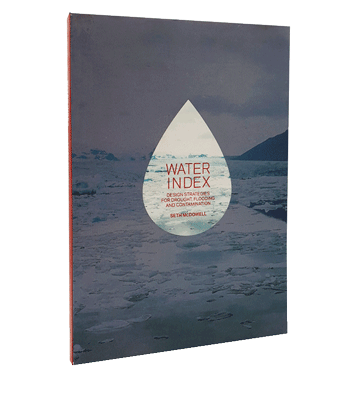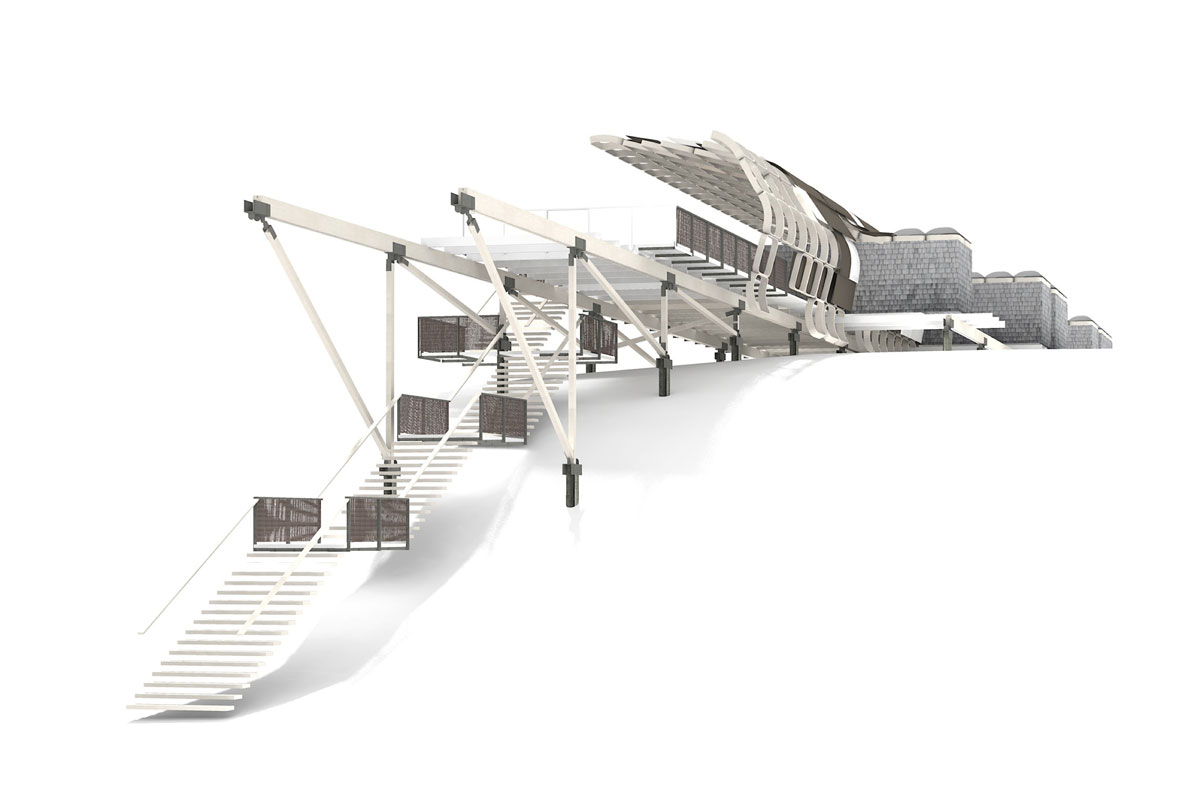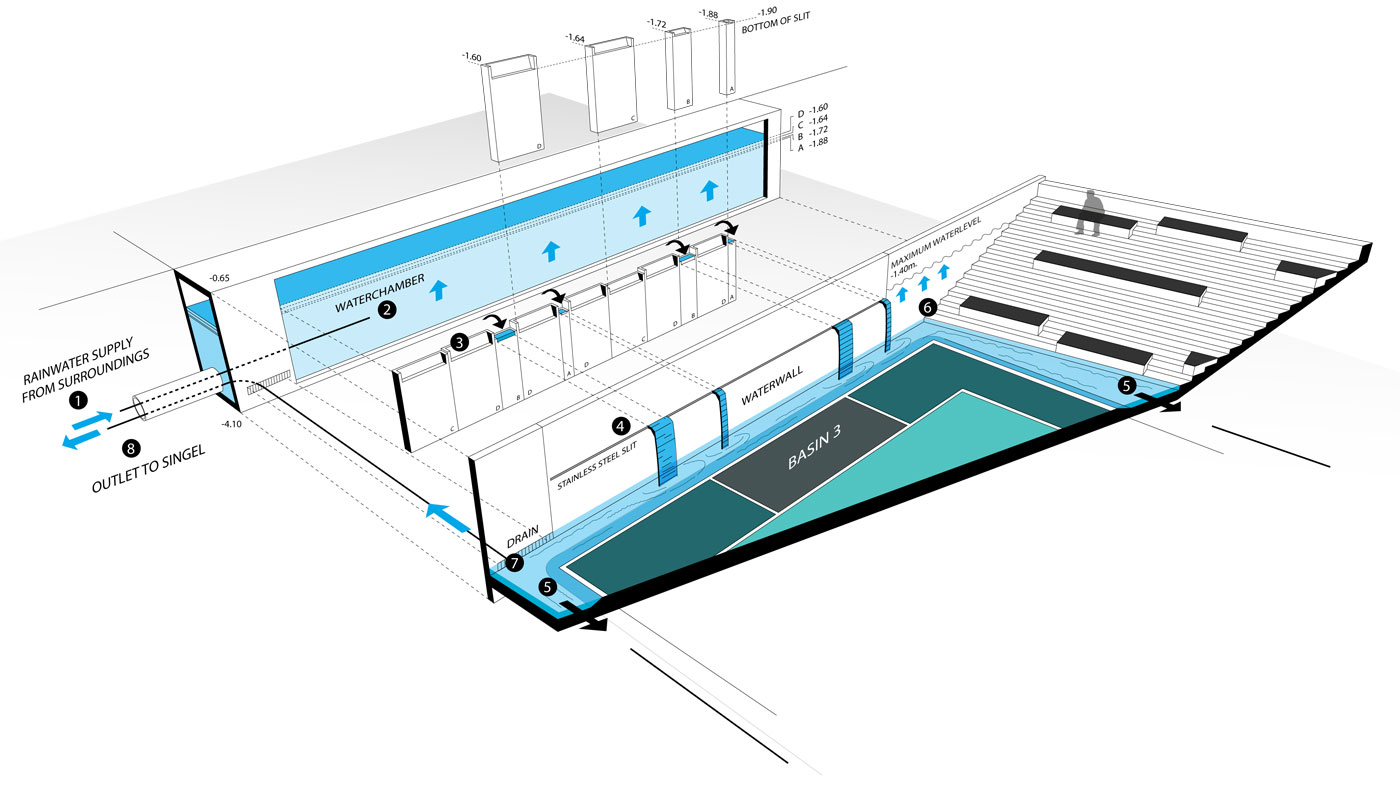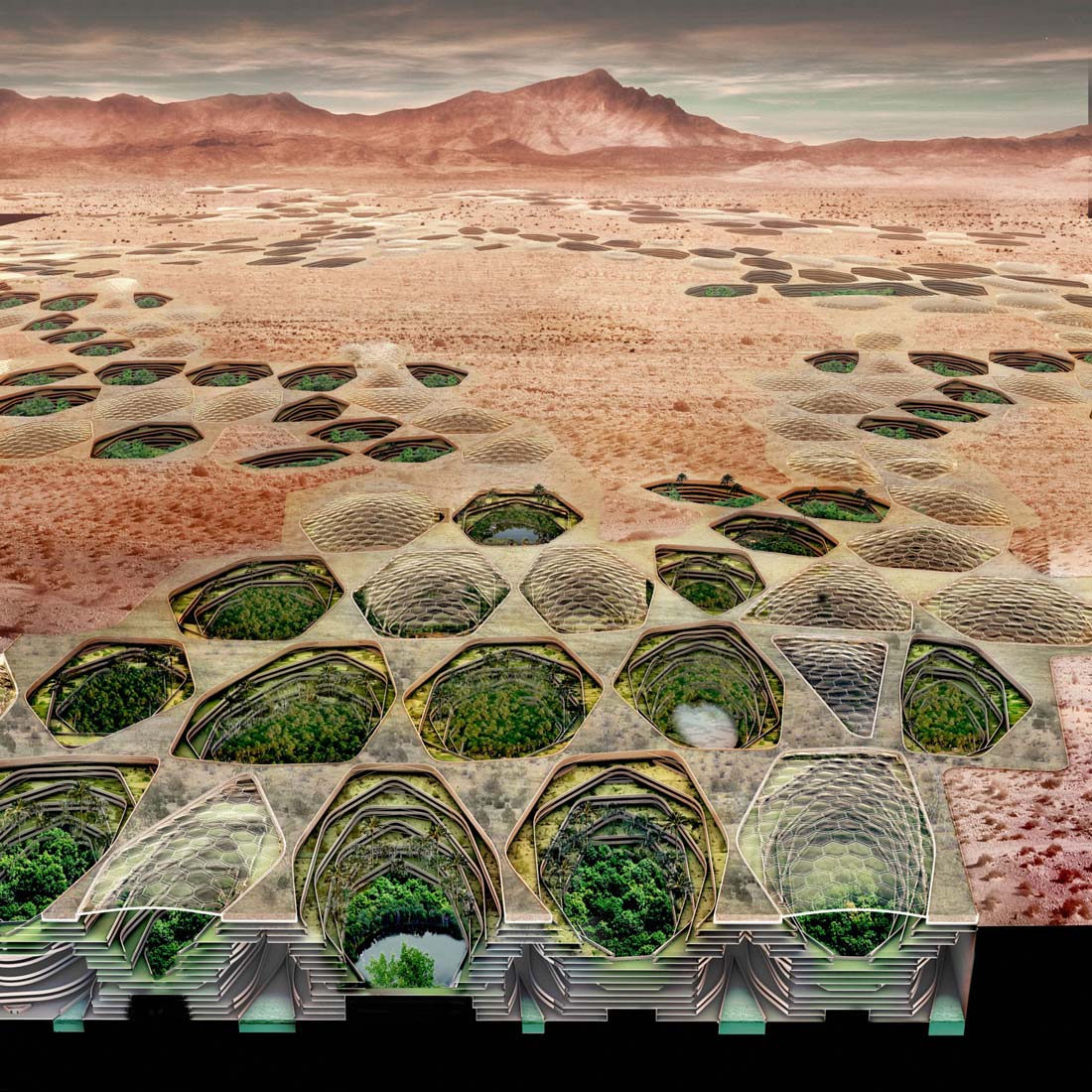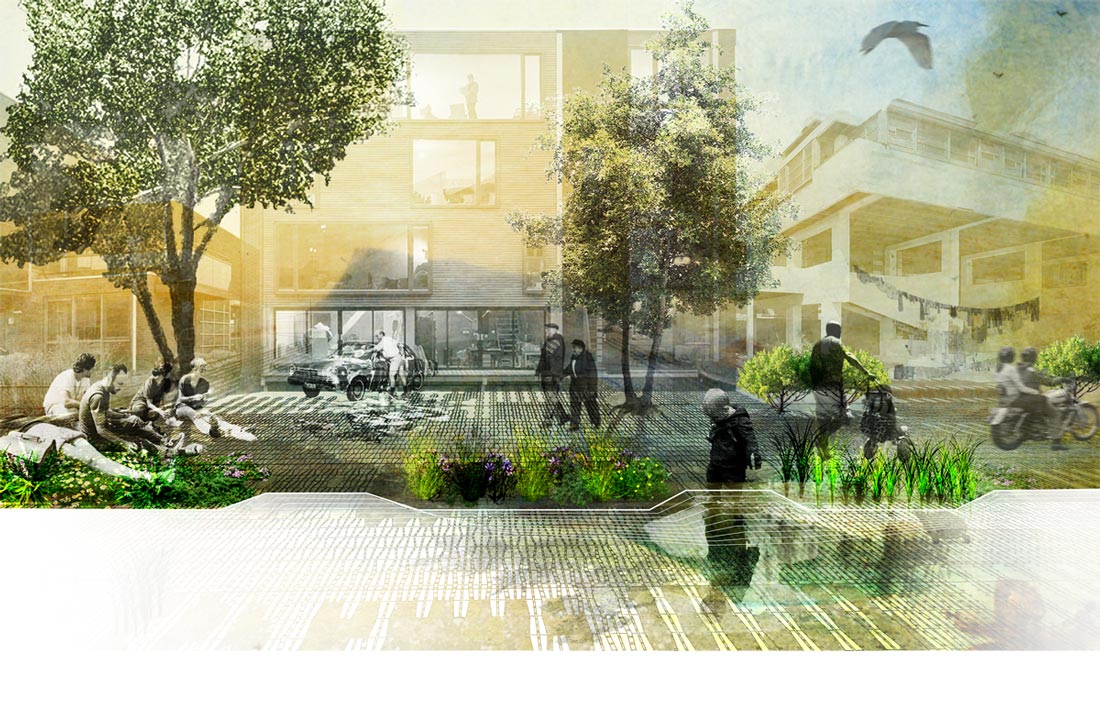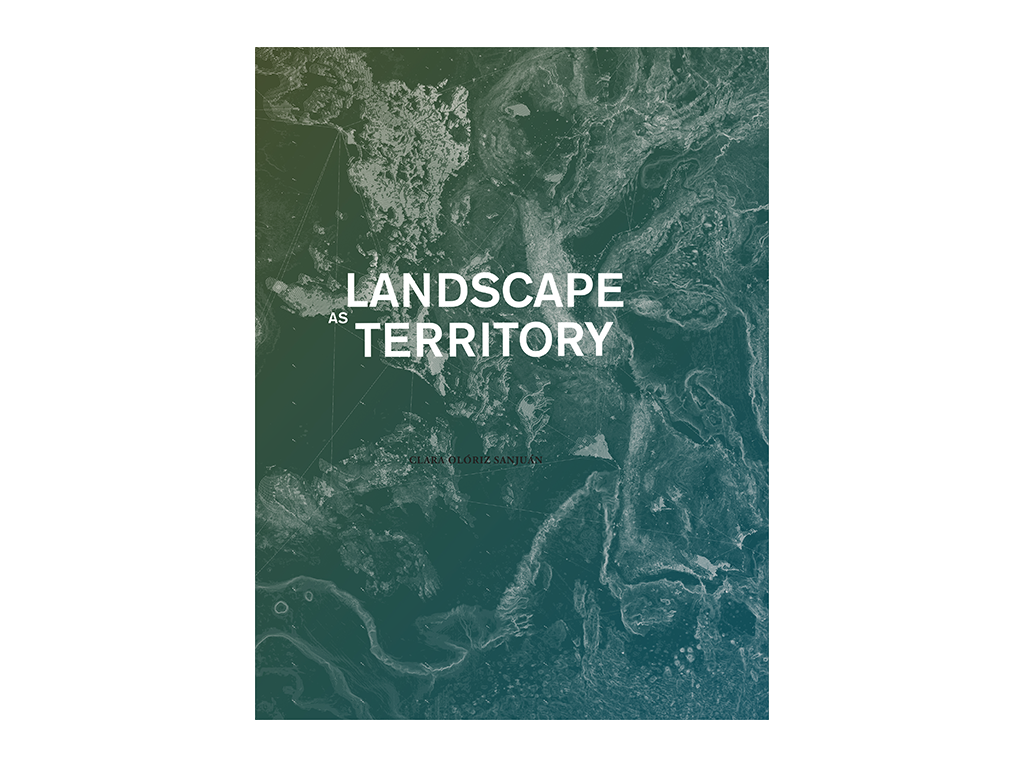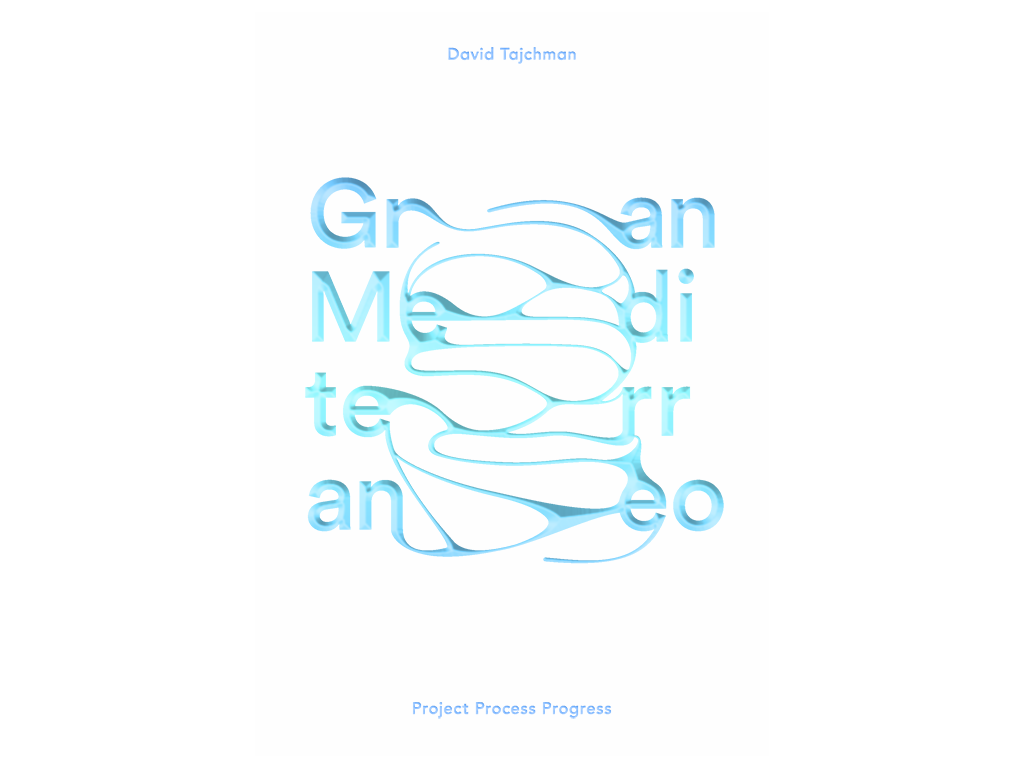Hieronymus Bosch’s “The Hell and the Flood”, a panel from the triptych Deliverance from the Deluge painted on the inside of an altarpiece, reveals an image of a post-apocalyptic landscape. The water has subsided, and rotting corpses of drowned sinners litter the land. This Old Testament narrative depicts water as a device for ethical cleansing. Yet, if the moral connotations are set aside, the Deluge in Genesis 8 is essentially a story of human’s technological adaptation to imposing natural phenomena. The ark, as a response for survival, has become the paradigm for humanity’s response to ecological disaster: construct a mechanism for deliverance. This paper is a catalog of mechanisms that enable the control of, escape from, and adaptation to water. Two hydrological crises are examined here, the rising and the disappearing of water, which present fundamental complications for humanity’s dependence on the natural resource. Each of these extreme conditions for water is evaluated relative to design strategies for defense, retreat, and adaptation.
Hieronymus Bosch, The Hell and the Flood, panel from Deliverance from the Deluge (circa 1450–1516). Oil, 27.2 x 15.4″. Museum Boijmans Van Beuningen, Rotterdam.
The first operation in response to extreme water situations relates to the strategy of defense. DEFCON, [1] the term used by the United States Armed Forces to describe the alert state known as a defense readiness condition, appropriately characterizes this militaristic approach to controlling water and water’s relationship with populations. The archetype for this strategy is the dam, the levee, or the aqueduct—engineered structures of a monumental scale that seek to defend against the given crisis. These are structures of the state, artifacts of modernity with the agenda of conquering, capturing, and distributing water for the purpose of progress. These tools for defense largely operate outside of a public realm; they are seen as mere infrastructure and are positioned at a distance from civic activities.
The second strategy examined is one of retreat. The archetype for this approach is the ark. It is a tool for escaping the crisis, a tool that enables mobility. This approach allows people, structures, and ecologies to migrate or relocate, prompting a repositioning relative to water. This strategy is interpreted in various ways, from a nomadic tectonic as seen in Benjamin Gregory and Edward Ford’s “Connections on Uncertain Ground” to the practice of establishing a new datum for inhabitation similar to West 8’s project for Governors Island Park, where imported fill and new topography are deployed as tools for elevating dry, safe ground.
The third strategy examined is adaptation. This strategy references the archetype of the step-well or bioswale as a mechanism that accepts, if not celebrates, the given hydrological instability. As opposed to the strategies of defense or retreat, adaptation allows water to invade the spaces of inhabitation, and the architectural and landscape interfaces then react to resolve or remediate the stressed water condition. Thus, urban space, landscape, and architecture are calibrated to respond to the fluctuations of an unstable aquatic ecology. This strategy is heavily situated in contemporary practice, where design intent is often framed as a response to ecological fluctuations. The approach can be seen in De Urbanisten’s Watersquare Benthemplein located in Rotterdam, where a public square becomes a pool during rainy seasons.
In the wake of an escalating global crisis with water, this paper is a critical inventory and analysis of innovative architecture and design solutions to address the rising and disappearing of water. As fear of ecological disaster ferments in contemporary architectural discourse, design competition briefs, conference topics, and journal themes optimistically call for designers to reconcile or reimagine the relationship between water, architecture, and the city. Anxiety is elevated by the onslaught of extreme weather in the form of superstorms, hurricanes, tsunamis, landslides, floods, and droughts whose frequency and intensity continue to increase. Couple the ever-present exposure to disaster with scientific data that suggests a future characterized by climate change and population growth, and we have the ingredients for a full-fledged paranoia: the perfect motivation for absurd, expansive, and radical building projects.
The Rising
For the last 2.5 million years, the earth has participated in an ecological dance with the massive continental ice sheets covering the northern hemisphere. This dance entails a constant oscillation between ocean levels and frozen water deposited in the glaciers—a give-and-take ballet that has instigated fluctuations in water level by more than 500 feet (150 m). “Shorelines have moved landward or seaward tens of miles as a result.”[2] Rising water level is not a recent phenomenon; it has been an unceasing operation over the history of the earth. What is urgent for us today is that water is approaching major centers of population and capital. We humans are the third, and somewhat awkward, participant in this environmental dance. For the first moment in earth’s history, sea level rise is encountering a densely developed edge condition, putting millions of lives, thousands of buildings, and hundreds of cities at risk.
This is the situation of the rising: water is breaching established thresholds and invading the city, architecture, and constructed landscape. The breach is no longer an anomaly, but rather a common occurrence, and is forcing us to rethink the built environment’s relationship with water. Is it possible to build mechanisms to keep the rising water out? If so, how long will these devices protect us? Should we flee, surrendering home and culture to the forces of nature? If so, where do we go? Is it possible to imagine an amphibious architecture? Can we build environments that have the ability to withstand or adapt to fluctuating water levels?
In Orrin Pilkey and Rob Young’s 2009 book The Rising Sea a critical call to action situates sea level rise within a global, historical context. The book recalls the “catastrophic submergence” of several ancient cities along the shores of the Mediterranean, including Alexandria, a city built by Alexander the Great, strategically located as a central harbor. [3] Pilkey and Young underscore that rising water is associated with disaster when it occurs instantaneously; such instantaneous sea level rise is a “surprisingly widespread phenomenon” linked to earthquakes, tsunamis, hurricanes, or storms. [4] Thus, exceptional climatic or geological events greatly heighten the built environments’ vulnerability to water.
“The countries with the biggest problems are the atoll nations; deltaic countries such as Egypt, the Netherlands, and Bangladesh; and countries with large, low-lying, heavily developed coastal plains such as the United States, Brazil, and China.”[5] For these areas there is an unrelenting sense of urgency: populations, capital, and cultures are at a high risk of being engulfed by the bodies of water surrounding them. Every city, building, and landscape residing in a delta or low-lying coastal plain must develop a strategy for dealing with the management of rising water, especially during extreme weather. The following projects present three strategic responses: a response of defense, a response of retreat, and a response of adaptation.
Defense as a design strategy for rising waters can be seen in projects like the 1935 Bonnet Carré Spillway in New Orleans or the Delta Works in the Netherlands. These modern engineering structures contain covert objectives entrenched in the “iconography of machine technology.” [6] Although these mechanisms for defense largely operate outside of a public realm, the monumental scale of the Bonnet Carré and Delta Works produce an engineered spectacle. The “stark modernist geometries” of the Bonnet Spillway, a common attribute of 20th-century flood- proofing infrastructures, render the ideologies of rationalization and control against the “dangerous beast” of unpredictable waterways. [7]
These two projects found in the deltas of Europe and United States share a common strategy of constructing large infrastructures to keep rising water levels away from people and the built environment. They present the archetype for defense—engineered structures of a monumental scale that seek to protect against water’s encroachment.
These are structures of the state, artifacts of modernity, with the agenda of conquering, capturing, and redistributing the natural fluctuations of water for the purpose of sheltering capital, culture, and people.
A second response to rising water levels within the territory of inhabitation is that of retreat. Projects using this strategy move people, buildings, and communities away from the threat. It is an operation of evacuation, of mobility, of migration. The archetype for this approach is the ark, a tool for escaping the crisis, a tool enabling mobility and prompting a repositioning relative to water.
This strategy can be interpreted by two formats in response to rising water. One approach is a nomadic exercise as seen in Benjamin Gregory’s “Connections on Uncertain Ground,” a project from Edward Ford’s graduate studio at the University of Virginia. Here, an architectural tectonic enables a building constructed on the receding Cape Cod seashore to periodically disassemble and retreat. It is an architecture that slowly migrates with a landscape in flux.
Benjamin Gregory, “Connections on Uncertain Ground”, Instructor, Edward Ford. University of Virginia, 2012.
Another interpretation of retreat is found in West 8’s project for Governors Island Park in New York City. This project withdraws from the water by establishing a new datum for inhabitation. The occupied ground is literally lifted out of the flood zone using imported fill to create a new topography: “By importing hundreds of thousands of cubic yards of fill material, West 8 has created a new island elevation that lifts the root zones of the new planting away from brackish water and above projected flood levels.” [8] These two projects reveal that retreat is both a vertical and a horizontal operation.
West 8, Governors Island Park and Public Space opened to the public in May 2014 Phase 2: Framing views of the Statue of Liberty from between the Hills © West 8.
The last strategy for addressing threats of rising water comes in the form of adaptation. This strategy references the archetype of the step-well, a mechanism that accepts, if not celebrates, hydrological fluctuations. As opposed to defending or retreating, adaptation allows water to invade the spaces of inhabitation, at which point the architectural and landscape interfaces act to negotiate and sustain the presence of water. Public space, landscape, and architecture are calibrated to respond to the fluctuations of an unstable aquatic ecology. This strategy is heavily situated within contemporary practice, where design intent often parallels tidal fluctuations.
Above: De Urbanisten, Watersquare Benthemplein, The Rain Wall dramatically deposits offsite water into the largest of the three basins. Below: aldayjover arquitectura y paisaje, Aranzadi Park, Diagrams demonstrating the change in the way the river floods, from simply spilling over its inclined banks as is the current condition, to a controlled meander which helps manage the river around the various programs on the site.
Two realized projects exploiting adaptation as strategy are aldayjover arquitectura y paisaje’s Aranzadi Park in Pamplona, Spain, and De Urbanisten’s Watersquare Benthemplein located in Rotterdam. Aranzadi Park presents a landscape that is calibrated to interact with the flood, and water is treated as a living material within a shared space. De Urbanisten’s Watersquare takes a similar approach, allowing the flood to invade the public space. However, this project is situated within the density of the city as a hardscape that transforms from public square to public basin with the weather. Both projects reveal that water can occupy civic space if the physical and natural interfaces are designed to sustain the dynamics of hydrology.
An academic project that deploys this operation of adapting to rising waters is Isaac Cohen, Kate Hayes, and Jorge Sieweke’s “Swamp Thing: Smart Grid, Smarter Water Management in New Orleans, LA,” which examines the complex delta region surrounding New Orleans and the Mississippi River. The project’s narrative is driven by the desire to unleash the Mississippi River, allowing the wild beast to “forge a new course, away from New Orleans.” [9] This project exemplifies the adaptive approach as it radically abandons static control systems and deploys “more progressive and adaptive” methods for managing water. Here, infrastructure is linked to ecology, and the swamp becomes a multifunctioning urban organism.
The Disappearing
The same quantity of water exists on the planet now as existed on the earth 5 billion years ago. Water is not disappearing from the planet, as all water is recycled. However, water is disappearing in key locations around the globe—locations where it is greatly needed for agriculture, manufacturing, energy, recreation, and human consumption. Growing populations in environments that are already water-stressed instigate the disappearance of water. Each year the earth’s population increases by 83 million more people, and water demand continues to rise. According to a 2010 National Geographic article, “Nearly 70% of the world’s fresh water is locked in ice and most of the rest is in aquifers that we are draining much more quickly than the natural recharge rate.” [10] In 15 years, 1.8 billion people will live in regions of severe water scarcity. [11]
Design projects situated within this context examine how cities, architecture, and landscapes work to counteract the depletion of water sources. Traditionally, distance has been a major obstacle in connecting thirsty populations to water sources. Development in the American West, in cities like Los Angeles or Las Vegas, depends upon the rerouting of distant water from the Colorado River. In undeveloped regions in the world, human feet traverse this distance, not networks of infrastructure. Women in developing countries walk an average of 3.7 miles to get water. [12] Thus, the critical element to examine in the “disappearing” of water is the relationship between population growth, resource depletion or recovery, and distance to an available water source. Design proposals confronting this problem generally take a position within the system of hydrological distribution: the point of intake, the line of transport, the pool of collection, or the point of outtake. They offer possibilities for living in arid, water-stressed environments.
William Morrish’s essay “The Urban Spring: Formalizing the Water System of Los Angeles,” first published in 1984 in Modulus volume 17, examines how a desert city is formulated by the parameters of water distribution and collection. In this early survey of Los Angeles’s water system, Morrish highlights how the extreme separation between point of intake and point of use instigates irresponsible water consumption habits. Morrish notes, “to the average person’s perception of the city, this labyrinth [of water infrastructure] remains hidden from view,” until they confront the water bill. [13] Thus, Moorish calls for a visual acknowledgment and celebration of water distribution systems in order to promote conservation efforts within the city.
The strategy to defend against the disappearance of water involves the construction of conveyance systems to bring water from distant lands to people, buildings, landscapes, and cities. Key tools that enable this importation are the reservoir, the aqueduct, and the pump. Remote access to water sources is overcome by engineering solutions that import water, such as South-to-North Water Diversion Project in China or The New Croton aqueduct that supplies New York City with water—two impressively gigantic projects that successfully and consistently deliver clean water to the metropolis.
An American city that has developed a relentless approach to defending against water’s disappearance is the city of Las Vegas. This city in the desert is playing a vicious game of importing water and fighting over ground rights for artesian wells. In 2013, the water level in Lake Mead reached its lowest point since it was filled in 1936. Since the Colorado River Compact was signed by seven states and Mexico in 1920, there has been a constant search for water sources to “augment” the supply of the Colorado River Basin. As early as the 1950s, major pipeline projects were proposed that would bring water from as far away as Alaska to increase the river’s flow. The latest big infrastructural idea: tap the Mississippi, and channel its excess waters across Iowa and Nebraska and into Colorado.
Of course, there are alternatives to laying hundreds of miles of pipe. Few people have had to consider them as much as Pat Mulroy. As the recently retired manager of the Southern Nevada Water Association, she has fought to stretch Nevada’s share of the Colorado River Compact, a paltry 350,000 acre-feet (as compared to California’s 4.2 million a-f) as far as it will Water is a right, she says. There’s plenty of it on this earth, it’s just a matter of getting it to where we need it. During her tenure, she diversified the “water portfolio” of Las Vegas Valley, gaining groundwater rights from other parts of the state, brokering deals with neighboring states to “bank” their water, and with the federal government to take advantage of flow “surplus.” The terminology surrounding water has moved from one of natural resource management to one of financial management. This thinking brings with it all the corollary tools to “end up in the black” that exist in the financial sector. Some of these tools are beneficial, as they increase the efficiency of management; drainage flow-return credits, interstate water banking and aquifer recharge, Colorado River Surplus, and water rights transfer/exchanges all help make the numbers work while carefully accounting for every drop of water. But as in the financial sector, the short-term game often doesn’t pan out in the long run.
Already stretched to its breaking point, the water supply system of Las Vegas is at a crossroads. The unpredictability of Colorado River water availability puts them at risk. As a result, negotiations within the closed system of the Colorado River Compact will provide only so much leverage. As Lake Mead shrinks and Las Vegas grows, it’s only a matter of time until a pipeline from the Mississippi, or some other distant source of water, becomes an urgent, and expensive, reality.
MATSYS, Sietch Nevada, 2009.
Retreat offers a second strategy for countering the effects of disappearing water. This approach entails moving people, wildlife, and the built environment away from stressed water environments and to new water-rich environments. This is seen in Sietch Nevada, a speculative fantasy by MATSYS, where a few remaining inhabitants have secluded themselves from the harsh environment of a dystopian world without water in what could be called a subterranean oasis. “Far from idyllic, these havens, known as sietch, are essentially underground water storage banks. Water is wealth in this alternate reality” writes Andrew Kudless, principle of MATSYS. It is preciously conserved, rationed with strict authority, and secretly hidden and protected. The project reveals a sectional retreat; similar to the approach that West 8 took to avoid water. Here, the city retreats downward, toward the subterranean aquifers as described in MATSYS’s project narrative:
“Inverting the stereotypical Southwest urban patterns of dispersed programs open to the sky, the Sietch is a dense, underground community. A network of storage canals is covered with undulating residential and commercial structures. These canals connect the city with vast aquifers deep underground and provide transportation as well as agricultural irrigation.” [14]
The Sea Tree by Waterstudio, is a project that imagines the sea as a new frontier enabling mobility and asylum from disappearing aquatic ecologies. This vertical island in the sea offers an alternate habitat for flora and fauna that must escape urbanization and desertification. While the project is dedicated to nonhumans, it could be imagined as a solution for human retreat as well, recalling Kikutake’s Marine City.
The third operation to combat the condition of disappearing water sources is to adapt and harvest, store, and restore healthy water within the spaces of cities, landscapes, and buildings. This is the contemporary strategy—if not obsession—where control of water distribution lies in the hands of the designer. The examples are plentiful for this strategy—just browse through the last five years of TOPOS journals, which has become a catalogue for water sensitive landscape projects.
Above: Project examples of adapting to disappearing water. Above: Antje Stokman, Bernd Eisenberg, Eva Nemcova, and Rossana Poblet “Lima Beyond the Park”, Construction of water-sensitive urban design prototypes during a summer school program in 2012. Below: Aja Bulla-Richards , “WASH: Urban Hydrological Networks for Resilient Cultural Ecologies”, Reimagining underutilized residential streets and front lawns creates public space that can support everyday rituals, expanding the experience of water in the urban landscape.
“Lima Beyond the Park” by Antje Stokman, Bernd Eisenberg, Eva Nemcova, and Rossana Poblet is one of the projects you will encounter in TOPOS. This project examines the Peruvian capital of metropolitan Lima, located on a desert coast overlooking the Pacific Ocean. With its more than 9.5 million inhabitants, Lima is considered the most extensive desert city in the world after Cairo. The project takes a multi-scalar approach to addressing the vast expansion of informal settlements and their lack of basic urban water services. The proposal considers urban, open space as a key ingredient to save water, purify water, treat wastewater, and recycle nutrients, or even to harvest water. Public space is coupled with water infrastructure, creating a spatial hybrid, a common format for adaptation.
“WASH: Urban Hydrological Networks for Resilient Cultural Ecologies” by Aja Bulla-Richards takes us back to Los Angeles and the problems outlined by William Morrish. This project proposes prototypical interventions that reconfigure stormwater and greywater infrastructure to initiate layered social and ecological structures in a typical Los Angeles neighborhood. Here, water shortage is addressed within the domestic space: the home, the yard, and the street become key components for a decentralized water-recycling intuitive. This approach begins to tackle the “out of sight out of mind” concerns acknowledged by Morrish by installing a decentralized water system at the point of use. The approach echoes a contemporary fascination with decentralized infrastructure.
From Controlled Nature to Calibrated Ecologies
This paper reiterates a vast transformation occurring in architecture, landscape architecture, and urban design—a transformation that is particularly evident in the fundamental relationship between human habitation and water. It is the transformation from the conquering paradigm, in which construction becomes a mechanism for controlling nature, to a more adaptive and responsive agenda in which construction is situated as a latent system, fluctuating in response to the forces of ecology. Computational and simulation tools now enable designers to precisely evaluate the symbiotic relationship between constructed and natural environments, prompting more responsive iterations in the technological conquest over nature. This evolving ecological precision encourages solutions of a calculated language. We have transitioned from a mode of controlled nature to the condition of calibrated ecologies.
The projects highlighted here embody this moment of calibrated ecology. While the imagery is dominated by blue and green, do not be seduced; these are often highly artificial environments, if not full-fledged mutants, whose ecosystems are generated through structured design operations. In an age of genetic engineering, design has adopted the ability to manipulate the DNA of natural systems in order to achieve an interdependent relationship between the constructed and the natural. For example, wave attenuation and water quality can be rectified by a biotic process of implanted oyster farming rather than by a hard control system of seawalls or filtration plants, as seen in the project “Parallel Networks” by OP.N’s Ali Fard and Ghazal Jafari—the winning project for the 2011 One Prize competition. In this project, a material intervention is introduced as a living system and positioned within an ecosystem as a latent yet productive infrastructure.
This approach of calibrated, adaptive design relies on process. Water is a variable system that has generated a preference for design solutions articulated as procedures. These solutions incorporate time, phasing logics, seasonal fluctuations, and changing datum. The ebbs and flows of water prompt an elongated time frame for design. Water- sensitive projects are not calculated for a single moment or ideal; rather, they have become responses to a series of possible futures or “what if” scenarios that span across time and varied conditions. This is the basis of an adaptive aquatic architecture: architecture embedded with a responsive intelligence that reacts to hydrological disruptions, fluctuations, and mutations.
Water has instituted a new materiality for 21st century design. The presence of water initiates growth systems that are formulated by environmental stimuli and controlled by design parameters. Many of the contemporary projects situated in extreme water environments examine material conditions that grow or mature, initiating remediation for water during their development, in a scripted choreography. Emerging aquatic systems act as material catalysts— placed in, on, or around water, they facilitate, rather than dictate, an action.
We are in a moment when designers and planners are exceedingly eager to devote all available professional and creative resources to the most relevant and urgent matters of the time, including water relations. In this scenario, crisis prompts design motives and design acts as a catalyst for recovery. This paradigm has been highlighted by Barry Bergdoll, former Philip Johnson Chief Curator of Architecture and Design at MoMA, and two MoMA exhibitions that situate designers in the midst of two global disasters: sea-level rise and economic recession. Both Rising Currents: Projects for New York’s Waterfront [15] in 2010 and Foreclosed: Rehousing the American Dream [16] in 2011 asked designers to rigorously analyze social, political, environmental, and economic problems and devise solutions that are both systemic and spatial. These two exhibitions became extremely charged while becoming vastly popular due to their ambition and relevancy. The projects signify that scientific and economic anxieties have infiltrated the world of architecture and architecture is grasping to remain relevant in a world fixated on uncertainty, and there is certainly nothing more uncertain.
